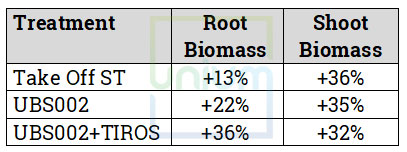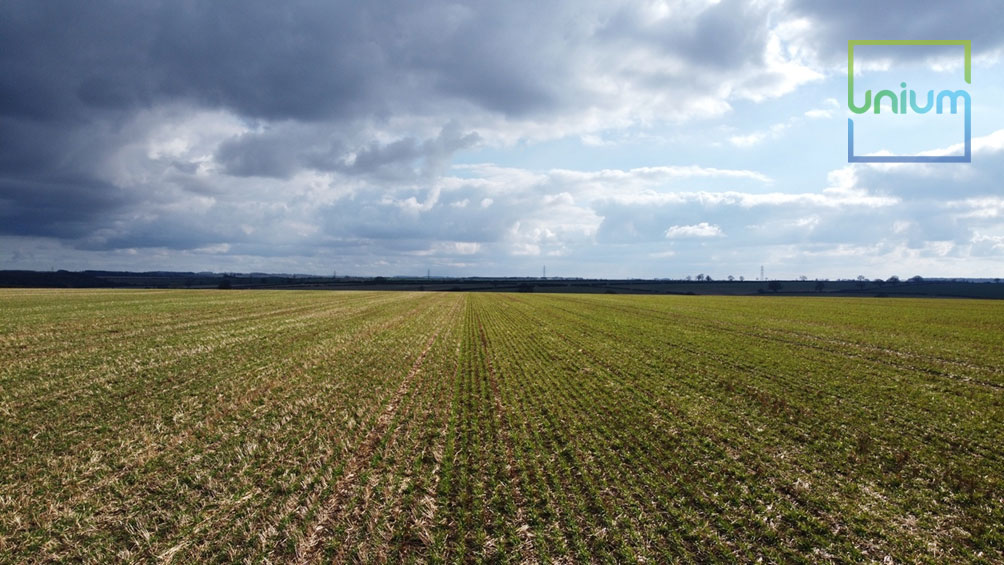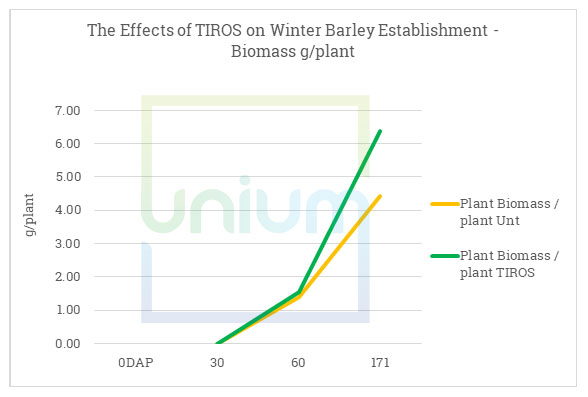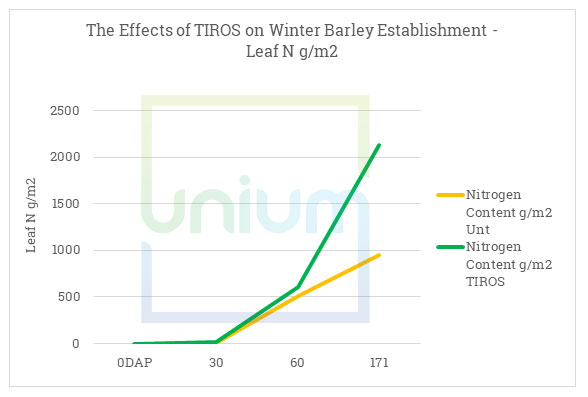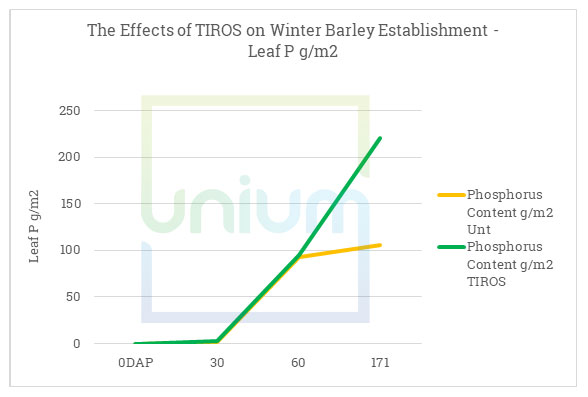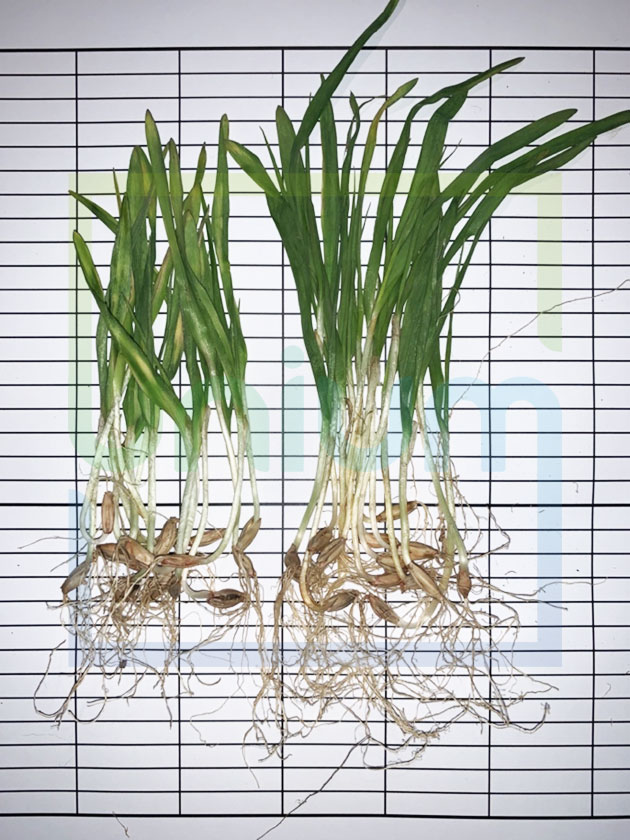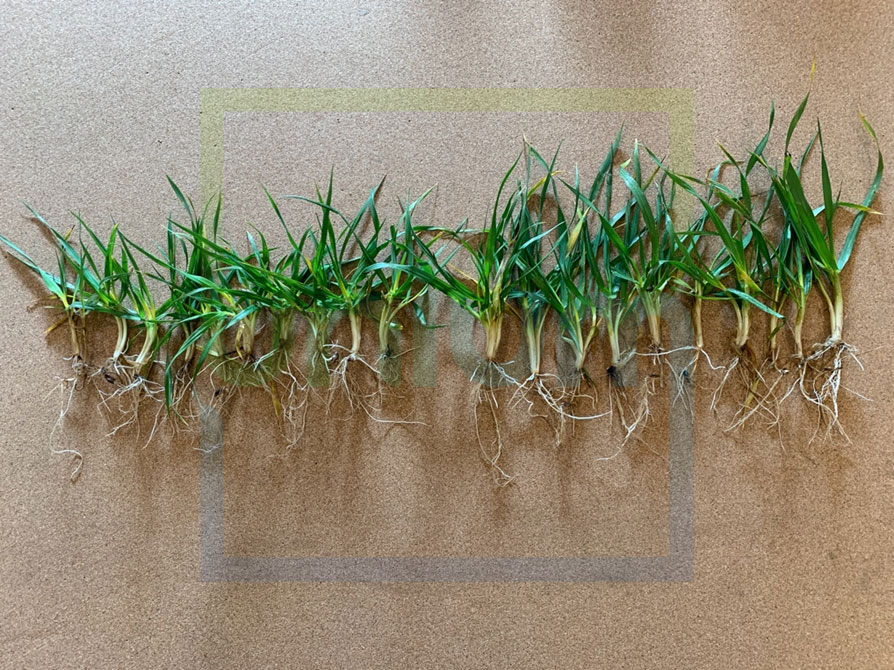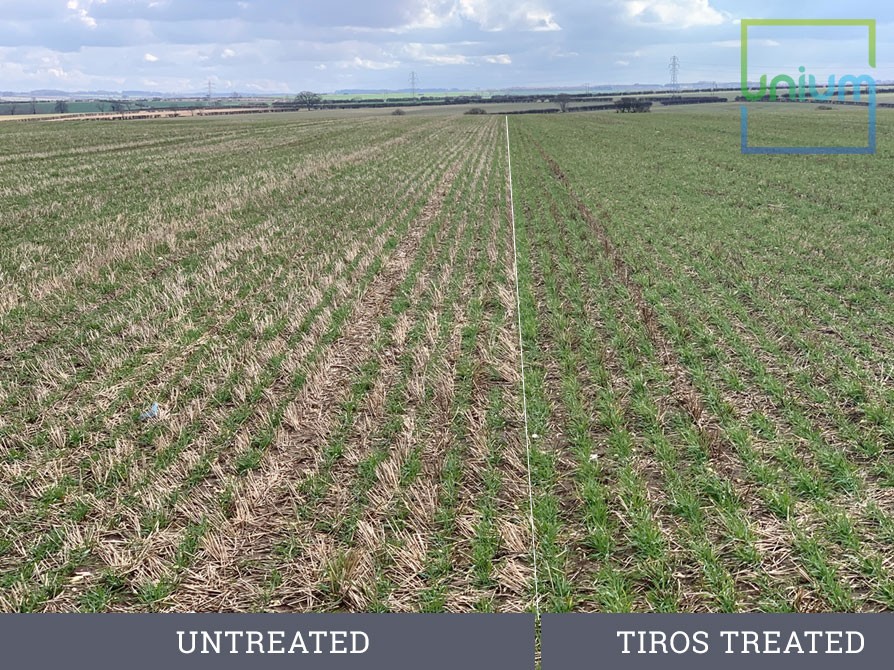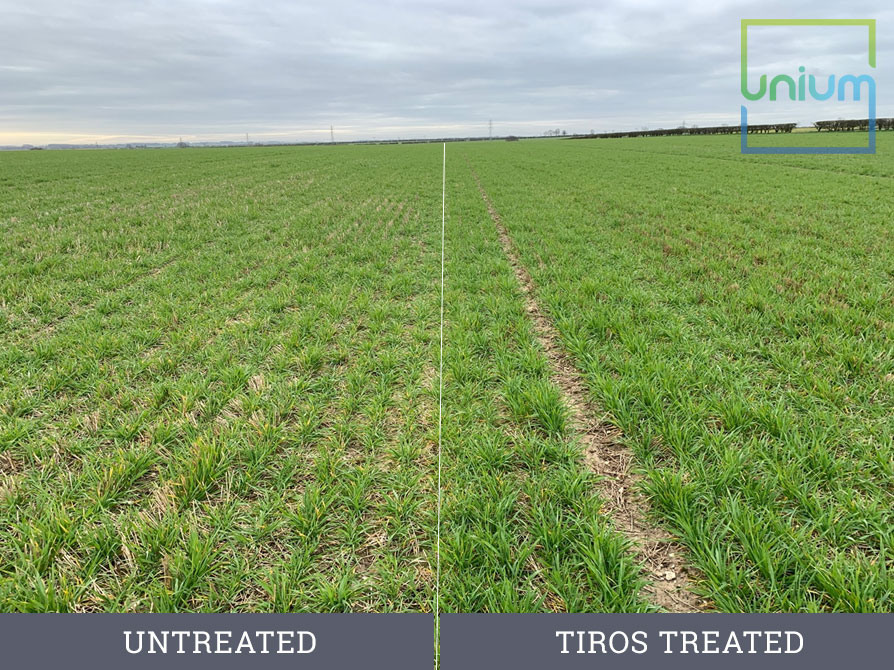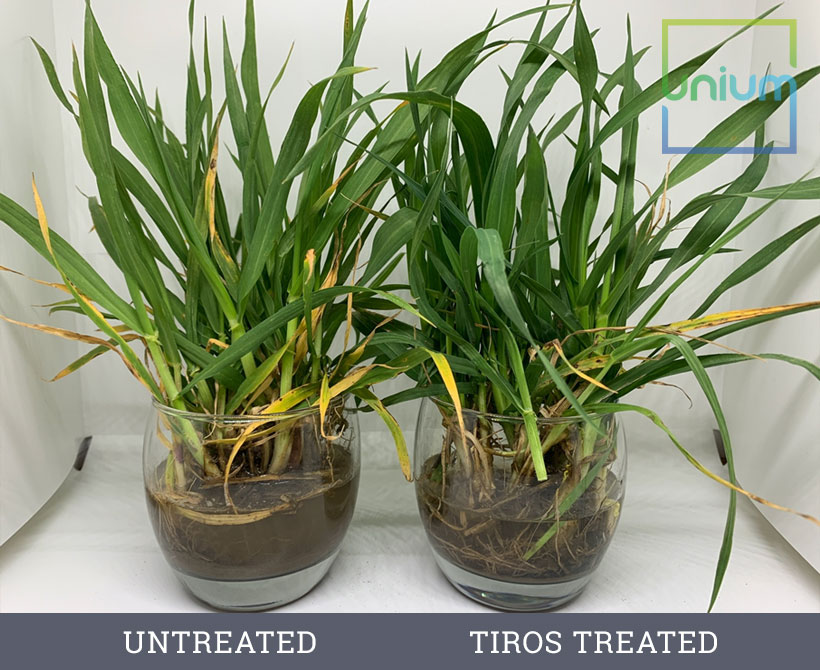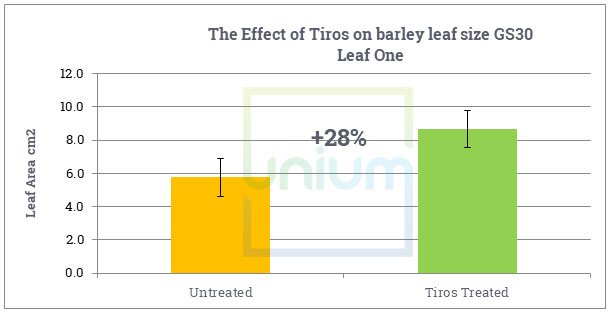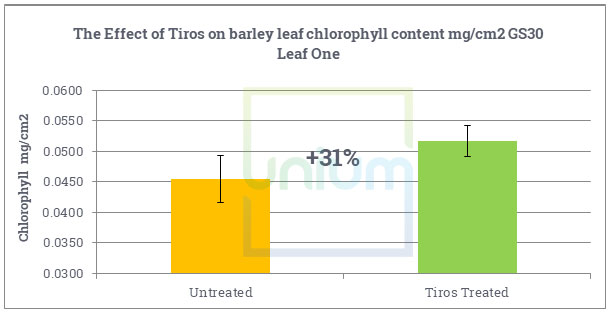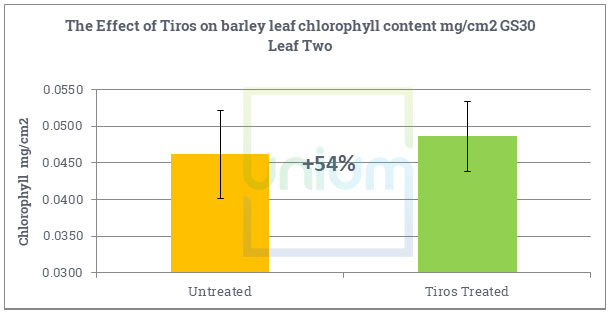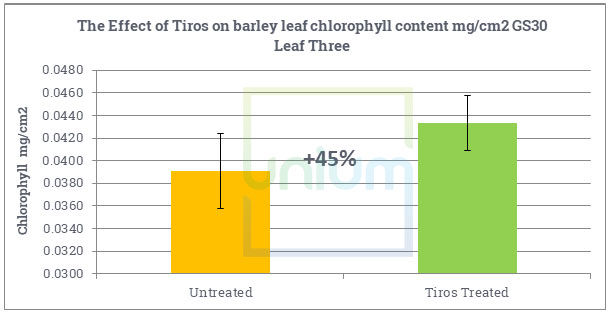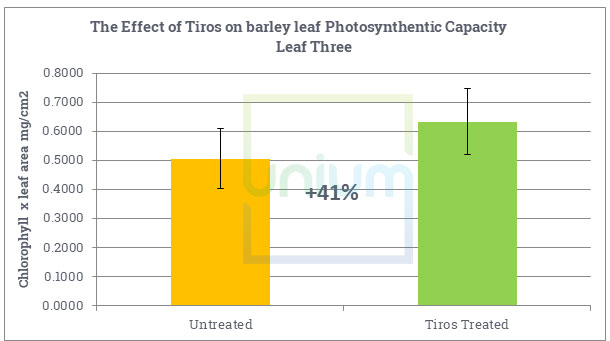Winter Barley
Winter barley is very source dependent and so it is vital to build biomass, tillers and ears.
Phosphorus is critical for a successful establishment.
Unium Biostimulants will give the best support through germination to tillering.
TIROS takes our seed treatments to a new level allowing the plant to continually fix nitrogen, sequester phosphorus and other nutrients from the soil through the life of the crop.
Winter barley has a different source sink relationship than that of wheat and therefore its management has to be considered differently to optimise its performance.
It is critical to build a strong root system, create optimal tillers and then support the building structure of leaves to maximise yield.
So a strong establishment is vital and adequate phosphorus to initiate tillering, with nutritional support to produce yield contribution during the season.
Cereals have 10-14 days of P contained within the seed to sustain growth before an external source has to be found, which is slightly more than oilseed rape. Phosphorus drives tillering initiation, so laying the foundations of yield starts with the seed. Seed treatments which place the required nutrition and stimulants in the vicinity of the developing roots allow the plants to establish quickly and achieve optimum growth, whatever situation they are in.
The scaffolding to support and enhance continued yield development comes from sequenced delivery of biological association, biostimulation and bioactive nutrition to build plant resilience during the growing season and maximise yield and quality.
The level of storage phosphorus (phytate) in seed shows that most cereals are similar on average, but there’s wide variability in barley and wheat. This highlights the need for careful attention to ensure phosphorus is available at the critical time.
As soil temperatures drop, P availability decreases in conjunction with the degree of vesicular‐arbuscular (VA) mycorrhiza colonisation. This is more important for late-drilled crops and wheat.
Honing-in on the establishment phase in more detail, a large amount of phosphorus is required relative to the size of the plant. It slightly exceeds the requirement for N and K, although the crop’s requirement for all the macro elements is elevated at this time.
Roots, in general, can only access P from within 1mm of the root hair, unlike N which can be obtained from 3-5 mm away. So it is critical to build biomass as soon as possible. P can only move approx. 25mm per year through the soil profile in contrast to N, which is highly mobile and can move the same distance in a week.
Temperature is unlikely to be a driver for P availability in winter barley. On average in September there is approx. 40% of soil P available for uptake by plants. The optimum soil pH is between 5 and 6.5, with fixation reducing availability from 60% to 20%.
There are many factors that can limit the availability of P to the crop during the establishment phase. This gets more complicated as it is a biologically-mediated nutrient, so protecting soil biology is critical. High levels of macro fertilisers have a negative impact on soil biology, particularly nitrate and phosphate.
Fertiliser applications can overcome this negative impact by making P more available for a time, but it will take time for the biology to recover and play a role in providing nutrition later on. Phosphite, on the other hand, does not impact negatively on soil biology, it stimulates root activity and increases nutrient availability.
Recent work at California State University, Chico (Stone, B. M.Sc. thesis 2011) has shown that 70% of soil bacterial populations, surveyed from natural soils in California, can metabolise phosphites as a P source.
Our aim is to maximise root depth, development and activity (exudation) so that we get the best establishment and tiller initiation to take the crop forward.
UNIUM SEED TREATMENT SUMMARY
Unium seed treatments (Boost, Tigga, Voltek) have been specifically designed to maximise root development. They provide phosphorus in a very available form at this key stage, as well as 2oxo/PGA to stimulate nitrogen assimilation, amino acids to support biology and other beneficial nutrients. This has taken biostimulant seed treatments to the next level setting new standards by improving:
- Root length,
- Root biomass,
- Shoot biomass and
- Photosynthetic capacity
These seed treatments have now been joined and are perfectly complimented by TIROS, the first global commercialisation of the endophytes discovered by Prof. S. Doty of the University of Washington.
The endophyte strains in TIROS have been specially selected over the past two decades for their specific nutritional efficiencies and confers the ability for plants to fix atmospheric nitrogen and to solubilise and sequester phosphorus (along with other nutrients). With more strains becoming available the biological arena represents an exciting new area of crop production
These endophytes live within the plant for the life of the crop and, as such, are much less susceptible to environmental stress compared with the biology that inhabits the rhizosphere. This helps to mitigate any environmental stresses that limit these two nutrients, increasing their bioavailability throughout the season.
TIROS is co-applied with our biostimulant package (Boost Bio, Tigga Bio, Voltek Bio) and supports the colonisation of the endophytes to maximise their effect.
So not only do you get the normal benefits you would expect from a Unium biostimulant seed treatment:
- Improved germination
- Enhanced established
- Promotes strong early growth
- Uniform stand
- Increased root length and biomass along with activity (exudation)
- Increased ability to withstand abiotic stress
- Improved overwintering survival
but the addition of TIROS adds even more nutritional enrichment. This extends beyond nitrogen and phosphorus because a balance is maintained when used in combination with a biostimulant. This means you don’t get leggy growth like you’d expect from more available N. The nutritional stoichiometry is maintained – keeping everything in balance for optimal growth.
The data below shows the comparison of the biostimulant seed treatments alongside TIROS. As it is applied with a Unium biostimulant, you would expect seed performance to be the same, but clearly it is quicker to germinate and produces more roots in the first 6 days to support establishment.
In Summary:
* UBS002 is Unium Biostimulant Seed Treatments
TIROS is an endophyte consortia.
So how did this perform in the field?
You can see as we trace biomass and nutritional status though the establishment phase into spring the difference with the additional biological support.
And when we did our final assessment at the end of May, we had set a larger photosynthetic capacity to build the yield required, which is the key determinant for barley yield.
Early November 2019
March 2020
April 2020
We look forward to bringing you the results on this trial and if it follows the results from spring barley, then an average 0.7 t/ha over 20 trials will be very welcome. TIROS along with its biostimulant component offers the best opportunity to get the crop off to a flying start.




